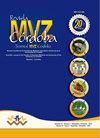Leptospira patógenas en murciélagos de Campeche y Yucatán, México
IF 0.3
4区 农林科学
Q4 AGRICULTURE, DAIRY & ANIMAL SCIENCE
引用次数: 9
Abstract
Objective. To report the infection with Leptospira in the kidneys of bats from Campeche and Yucatan, Mexico, through the amplification by PCR of two different 16S RNA ribosomal gene fragments. Materials and methods. Bat captures were made at one site in Campeche and two sites in Yucatan. Euthanasia was applied to the captured bats and a necropsy was performed to collect a renal tissue sample that was used in the total DNA extraction. Two different conventional PCR were performed for the amplification of the 16S RNA ribosomal gene fragments. Some sequences from positive products were obtained and analyzed with bioinformatics tools to identify the infectious species of Leptospira. Results. Sixty-nine bats belonging to four families and eight different species were captured. The family with the greatest diversity was Phyllostomidae, with five species. The most captured species was Artibeus jamaicensis (41, 59.4%). Both PCR showed a global infection frequency of 21.7%. The infected species were A. jamaicensis, Pteronotus parnellii, and Chiroderma villosum. The bioinformatic analysis of the positive products yielded a 99.0% identity for Leptospira noguchii, Leptospira borgpetersenii, and Leptospira santarosai. Conclusions. Some bat species of Yucatan and Campeche, Mexico, are renal carriers of pathogenic Leptospira, therefore participating in the transmission cycle in the region. The frequency of infection found in the renal tissue of the captured bats is higher than the one obtained from other reservoirs captured in Yucatan and Campeche. New species of bats are reported as renal Leptospira carriers in Mexico.墨西哥坎佩切和尤卡坦蝙蝠中的致病性钩端螺旋体
客观的通过PCR扩增两个不同的16S RNA核糖体基因片段,报道墨西哥坎佩切和尤卡坦蝙蝠肾脏中钩端螺旋体的感染情况。材料和方法。在坎佩切的一个地点和尤卡坦的两个地点捕获了蝙蝠。对捕获的蝙蝠进行安乐死,并进行尸检以收集用于总DNA提取的肾组织样本。进行两种不同的常规PCR以扩增16S RNA核糖体基因片段。从阳性产物中获得一些序列,并用生物信息学工具进行分析,以鉴定钩端螺旋体的感染物种。后果捕获了69只蝙蝠,分属四个科和八个不同的物种。多样性最大的科是叶藻科,共有五个物种。捕获最多的物种为牙买加Artibeus jamaicensis(41.59.4%)。两种PCR均显示全球感染频率为21.7%。感染物种为牙买加a。阳性产物的生物信息学分析显示,诺古奇钩端螺旋体、博格彼得森钩端螺旋菌和桑托罗赛钩端螺旋虫的同一性为99.0%。结论。墨西哥尤卡坦和坎佩切的一些蝙蝠物种是致病性钩端螺旋体的肾脏携带者,因此参与了该地区的传播周期。在捕获的蝙蝠的肾组织中发现的感染频率高于在尤卡坦和坎佩切捕获的其他水库中发现的。据报道,墨西哥有新的蝙蝠携带钩端螺旋体。
本文章由计算机程序翻译,如有差异,请以英文原文为准。
求助全文
约1分钟内获得全文
求助全文
来源期刊

Revista Mvz Cordoba
农林科学-奶制品与动物科学
CiteScore
0.70
自引率
0.00%
发文量
41
审稿时长
6-12 weeks
期刊介绍:
The Journal MVZ Córdoba is an open access international scientific journal financed and edited by the University of Córdoba (Colombia). The journal publishes quarterly, continuously in PDF, XML, Epub, original articles, literature reviews, brief communications and clinical cases, peer-reviewed (double-blind) in Spanish and English, which are related to the agricultural and veterinary sciences. The journal is directed to natural and legal persons of veterinary medicine, animal husbandry, public health, epidemiology, aquaculture, biology, basic biomedical sciences and biotechnology and constitutes a space for academic and scientific discussion around the work of professionals in Veterinary Medicine and Zootechnics. Four-monthly publication.
"The Journal MVZ Córdoba supports the policies for registration of clinical trials of the World Health Organization (WHO) and the International Committee of Medical Journal Editors (ICMJE), since it recognizes the importance of these initiatives for international registration and dissemination. of information about clinical studies, in open access. As a result, since 2007, the journal MVZ Córdoba only publishes clinical research articles that have received an identification number in one of the Clinical Trial Registries validated by the criteria established by WHO and ICMJE, whose addresses are available in the ICMJE website. The identification number is recorded at the end of the summary. "
 求助内容:
求助内容: 应助结果提醒方式:
应助结果提醒方式:


